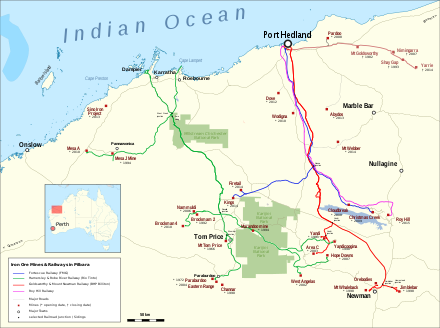Goldsworthy railway
The Goldsworthy railway, owned and operated by BHP Billiton, is a private rail network in the Pilbara region of Western Australia built to carry iron ore. It is one of two railway lines the group operates in the Pilbara, the other being the Mount Newman railway.[1]
| Goldsworthy railway | |
|---|---|
.jpg) | |
| Overview | |
| Type | Heavy rail |
| Status | Operational |
| Locale | Pilbara, Western Australia |
| Termini | Yarrie mine Finucane Island |
| Operation | |
| Opened | 25 May 1966 |
| Operator(s) | BHP Billiton |
| Depot(s) | Port Hedland |
| Technical | |
| Line length | 208 km (129.25 mi) |
| Track gauge | 1,435 mm (4 ft 8 1⁄2 in) standard gauge |
In addition to the BHP Billiton network, there are two more independent iron ore rail lines in the Pilbara. One is operated by Rio Tinto, the Hamersley & Robe River railway,[2] while the other, operated by the Fortescue Metals Group, is the Fortescue railway.[3]
History

In May 1966 the 112 kilometre Goldsworthy railway opened to transport iron ore from Mount Goldsworthy mine to the port on Finucane Island.[4] The line was extended to Shay Gap in 1972 and Yarrie mine in 1993.[5]
On 1 March 1991 the Goldsworthy Mining and Mount Newman Mining were amalgamated under the BHP Iron Ore brand.[6]
In June 2004, the National Competition Council of Australia received an application from the Fortescue Metals Group (FMG) to use part of the Mount Newman railway and also part of the Goldsworthy railway.[7]
In June 2010, the Australian Competition Tribunal ruled that FMG be granted access to Rio Tinto's Robe River line and BHP Billiton's Goldsworthy line but not to the busier Hamersley and Mount Newman lines.[8][9] Treasurer Wayne Swan suggested that several advantages would accrue from access to the rail lines by third parties. It would increase competition, reduce duplication of infrastructure, and reduce environmental damage.[10]
Access to the rail networks by third parties is governed by the State Agreements Act.[11]
Operation
The Goldsworthy railway is 208 kilometres (129 mi) long, connecting the Yarrie mine to Finucane Island, near Port Hedland.[1]
Unlike Mount Newman line trains, with up to 208 wagons per train, Goldsworthy line trains only have 90 wagons per train. Each wagon carries up to 126 tonnes (124 long tons; 139 short tons) of ore.[1]
Rolling stock
In December 1965 Mount Goldsworthy Mining Co took delivery of two English Electric, Rocklea locomotives (no 1 & 2) to the same design as the Western Australian Government Railways H class. Initially used on construction trains, they were later used on general freight trains and shunting duties. One was written off in an accident in 1968 with some parts incorporated into a new frame built by English Electric in 1970.[12][13]
In 1966 the first of six English Electric, Rocklea built locomotives (no 3 to 8) to the same design as the Western Australian Government Railways K class. After one was damaged in 1968, a K class was purchased from the Western Australian Government Railways followed by another in July 1986.[14] In November 1992 all were transferred to BHP's Port Kembla operation.[15] By this stage the infrastructure had been upgraded to allow GE Transportation 36-7 locomotives to take over the line.[6]
In 1990 Clyde Engineering built GML10 was purchased. It was sold to Comalco in August 1994.[16][17]
In March 2012, BHP Billiton placed an order for 80 Electro Motive Diesel SD70ACe/LCi locomotives for use on its Western Australia mining railroads.[18]
References
- Rail BHP Billiton
- Rail Rio Tinto
- Railroad Operations Fortescue Metals
- Mt Goldsworthy Mining Legacies
- Yarrie, Mt Goldsworthy, Nimingarra, Sunrise Hill, Shau Gap and Cundaline Porter GeoConsultants
- "Impressions of the Pilbara" Railway Digest February 1999 pages 18-27
- Application for declaration of the Mt Newman Railway National Competition Council of Australia
- Junior miners win limited access to Pilbara rail network Archived 14 March 2012 at the Wayback Machine lloydslistdcn.com.au, published: 1 July 2010, accessed: 4 November 2010
- Watchdog 'can demand Pilbara rail expansion' The Australian, published: 13 May 2010, accessed: 4 November 2010
- BHP Billiton, Rio Tinto angry on open Pilbara rail line news.com.au published: 28 October 2008, accessed: 4 November 2010
- Report on Current Transport and Communications Infrastructure in the Pilbara Murdoch University, accessed: 4 November 2010
- Oberg, Leon (2010). Locomotives of Australia 1850s-2010s. Kenthurst: Rosenberg Publishing. p. 326. ISBN 9781921719011.
- Goldsworthy Mining - Goldsworthy No 1 Pilbara Railways Historical Society
- Oberg, Leon (2010). Locomotives of Australia 1850s-2010s. Kenthurst: Rosenberg Publishing. pp. 340–342. ISBN 9781921719011.
- Port Kembla - Diesel Locomotive Fleetlisting Light Rail Research Society of Australia
- Oberg, Leon (2007). Locomotives of Australia: 1850s-2007. Rosenberg Publishing. p. 411. ISBN 1-877058-54-8.
- "Around Australia with R1004 and friends" Railway Digest April 2011 page 26
- "BHP Billiton places large heavy haul locomotive order". Railway Gazette International. 2 March 2012. Archived from the original on 5 March 2012. Retrieved 14 March 2012.
External links
- BHP Billiton website
- Pilbara Railways – rail enthusiast website
- West Aust Railscene eMag (weekly, free) – frequently includes images of, and short notes on, Goldsworthy railway operations